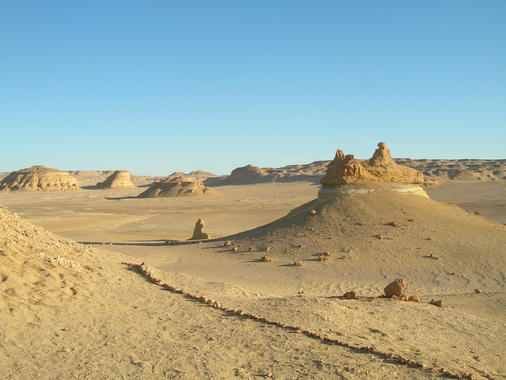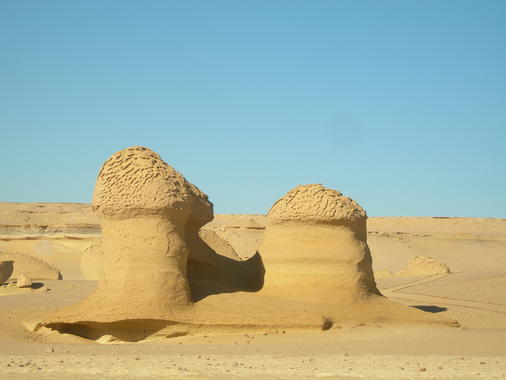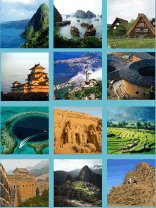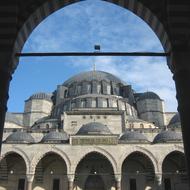Guide 8 – Case Study: Wadi Al-Hitan (Egypt)
Baseline situation
Wadi Al-Hitan – also known as Whale Valley – is located in the Western Desert of Egypt. It is an ‘open-air museum’ of invaluable fossil remains of the earliest, and now extinct, suborder of whales (Archaeoceti), as well as other prehistoric fossil remains and diverse living wildlife. The sheer number, concentration, quality, and accessibility of the evidence saw Wadi Al-Hitan inscribed on the World Heritage List in 2005. It is state-owned and has strong legal protection under the Egyptian Law for Nature Protectorate Reserves, forbidding actions that would lead to the destruction or deterioration of the natural environment.
The main visitor groups are foreign tourists who usually camp overnight at the World Heritage site, which is difficult to reach. Since the implementation of sustainable tourism strategies at Wadi El-Rayan Protected Area (WRPA), of which Wadi Al-Hitan is incorporated, tourist numbers have steadily increased – around 12,000 visitors were recorded in 2008.

What did they do?
The means through which visitors could access the site were restricted to allow better control over visitor numbers. Vehicles are prohibited, and Wadi Al-Hitan can only be visited through prearranged guided tours along a set trail, either by foot or on camel. Zoning across the WRPA leads to controlled eco-tourism in some areas, while maintaining others for research and study; and the well-designed visitor facilities guide people to the key sites via footpaths and provide limited on-site accommodation.
Strategic priorities
- Preserve the integrity and natural beauty of Wadi Al-Hitan.
- Enable the continuation of scientific research on the prehistoric remains.
- Establish a system of sustainable tourism that benefits both the needs of such a fragile site and those of the local community.
What worked?
The primary concern is safeguarding the highly delicate fossil remains, and this has been achieved through restricting visitor access. Under the Management Plan (2008-2013) developed for the World Heritage site, this property is identified as a ‘World Heritage Zone’. No vehicle access is permitted, and zoning of the property provides for controlled eco-tourism in some areas, while maintaining others for research and study. All visits must be prearranged so that the maximum number of visitors allowed to access the site at any one time is not exceeded. Due to the remote nature of the site, tourists can camp overnight, which reduces the need for permanent built infrastructure that would infringe on the natural and prehistoric landscape of Wadi Al-Hitan.
The buffer zone is also managed as a part of the World Heritage Zone within the WRPA. Effective and well-designed visitor facilities guide visitors to key localities via footpaths. Through ensuring that each visiting group is accompanied by an allocated trek guide, the actions of visitors can be monitored and any negative impact on the site minimized. Access points to the site have also been reduced and the perimeter of the World Heritage site is under surveillance to minimize the opportunity for unauthorized visitors.
In addition to the visitor management strategies, Wadi Al-Hitan incorporates the local communities, businesses and other stakeholders in managing the area; promoting Wadi Al-Hitan as a leading site for non-intrusive eco-tourism and environmental education, as well as making sure that the conservation and development of the site is financially sustainable. In 2014 Wadi Al-Hitan attracted fundraising from Italy to install solar panels, which demonstrates how a successfully run World Heritage site can attract financial help to further the goals of the site.
What was tough?
Wadi Al-Hitan covers an area of approximately 200km2 (not including buffer zone), so securing the area from unwanted visitors, for example, illicit trafficking of fossils or conducting of unauthorized excavation, was a key challenge. There was a lack of immediate funding, and no financial assistance from the private sector to help develop the infrastructure or provide the staff training that was needed to make a change. Prior to Wadi Al-Hitan’s inscription on the World Heritage List, there was also no policy to limit tourist access or restrict numbers and vehicular access.
How did they get buy-in?
The new restrictions to Wadi Al-Hitan and the requirement that all tours are accompanied by a guide opened up opportunities for developing new businesses and ongoing employment for local communities and residents.
What are the results?
Improved conservation, increased perception of the value, and community development are the three factors identified by the International Union for Conservation of Nature (IUCN) as positive impacts from current management strategies and tourism at Wadi Al-Hitan. Restricting tourist numbers has meant that built infrastructure can be kept to the bare minimum, reducing any potential impacts. Implementing guided tours and operating extensive surveillance to limit unauthorized access has also reduced any negative impact (damage or theft) on the fragile fossil remains spread across the World Heritage site.
As well as strict visitor management, community involvement is promoted at Wadi Al-Hitan – the tourist trade has been developed at a small scale with local entrepreneurs. Capacity building around tourism and awareness-raising about the site were some of the key priorities for local communities, and these have had positive effects in improving local understanding and financial benefits for local businesses.
What lessons can others take from this?
Fragile heritage requires special measures to conserve it, reduce any negative impact, and preserve the OUV. For the majority of World Heritage sites, this will require putting into place measures that restrict visitor access, such as set tour routes or visitors pre-booking excursions.
Wadi Al-Hitan has extensive archaeological remains, some of which are still undiscovered and undocumented, so special measures have been taken to ensure that these unexcavated remains are protected and subject to minimal tourist impact or unauthorized intrusion (zoning: ‘tourist routes’ and ‘inaccessible zones’). Such courses of action require man power and the commitment of local residents and tour guides – it is important to ensure that the strategy to limit tourist impact does not also negatively affect local communities, and that an incentive (ideally financial) exits to ensure the ‘buy-in’ of stakeholders.



